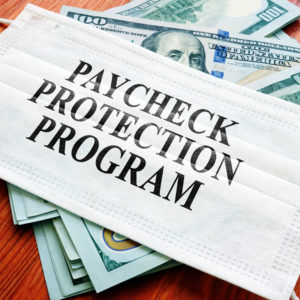In a recent economic research paper (“Did the Paycheck Protection Program Hit the Target”) by economists from the University of Chicago’s Booth School, Massachusetts Institute of Technology’s Sloan School and the National Bureau of Economic Research, only about 15 percent of companies in U.S. regions with the largest declines in hours worked and most business closures received loans from the initial $349 billion tranche of the Paycheck Protection Program.
Additionally, the researchers uncovered that the nation’s top four lenders (JP Morgan Chase & Co., Bank of America Corp., Wells Fargo & Co., and Citigroup Inc.) disbursed less than 3 percent of PPP loans in the first tranche — drastically lower than the usual one-third of all small-business loans these financial institutions normally provide to this business community.
In response to criticism of the first round of PPP loans disbursed, the U.S. Small Business Administration and the Treasury Department, in a joint statement, reported that “the vast majority of these loans — 74 percent of them — were for under $150,000, demonstrating the accessibility of this program to even the smallest of small business.
But an SBA report also noted that about 2 percent of the firms approved for PPP loans accounted for almost 30 percent of the funding.
In a recent review of more than 200 publicly traded corporations receiving more than $750 million in PPP loans (although these “loans” are actually grants, since the terms of the agreement forgive the loan if a business uses 75 percent of the funds for payroll and it maintains its employee head count) by The New York Times reveals that a dozen of these large companies had recently acknowledged their access to available private market capital, and then applied for and received millions of dollars in PPP loans.
Moreover, the Times reports that several other firms have recently awarded top executives seven-figure compensation packages, while dozens of large corporations with financial or legal problems have also received major loans under the PPP program.
In contrast, there have been reports of countless small-business owners who have had to lay off employees and face bankruptcy because they could not get access to PPP loan funds.
On April 20, the National Small Business Association released the results of its online survey (“COVID-19 Relief”) of more than 980 small-business owners and found that of small businesses with 10 or fewer employees, only 18 percent were approved for their PPP applications, while among those businesses with more than 20 employees, there was a 52 percent approval rate.
While some of these larger firms, such as Shake Shack, Potbelly’s, Ruth’s Chris Steak House, Auto Nation and the Los Angeles Lakers have returned millions of dollars in PPP loans to the Treasury, most other large firm recipients have not yet joined them.
Whether they actually needed the money or not, these larger companies simply viewed the PPP loan as “free” money, and in some cases, their bankers encouraged them to apply for the PPP loans.
Moreover, under SBA guidelines, a loan recipient must be a business with fewer than 500 employees and revenue of less than $2.5 million annually, but makes exceptions for restaurants and other food-service businesses that employ fewer than 500 workers per location.
This SBA lending guideline resulted in the granting of a combined $40 million in PPP loans to Shake Shack, Ruth’s Chris Steak House and Potbelly’s — all large chain restaurants not the intended target for these loans.
As greater disclosure of the large companies representing the 2 percent who received nearly 30 percent of the PPP loan funds becomes public, the reputational damage to “Big Business” increases — and this sector can ill afford it.
In Gallup’s 2019 annual poll of “Americans Confidence in Institutions,” the U.S. public awarded a 68 percent favorable rating (combining the two highest consumer rankings) for “Small Business,” versus a dismal 23 percent favorable rating for “Big Business.”
What policies should be implemented to deal with the failures resulting from the first round of PPP loans?
First, President Trump has emphatically stated that he expects those large corporations that have accepted PPP loans to voluntarily return the money to the federal government. An additional incentive, a media-based “Hall of Shame,” should encourage this “voluntary” corporate behavior.
Second, if the “voluntary” approach proves unsuccessful, the Congress could pass legislation rescinding the PPP loans of those recalcitrant large firms.
Third, these “Big Business” eligibility loopholes — a government failure — should be eliminated in the most recent round of $310 billion in PPP loans. Yet, with low-interest loan monies readily available to them in private capital markets, large firms should not be considering applying for this most recent tranche of PPP funding.
“Big Business” boards of directors need to practice corporate responsibility by leading America back to economic recovery, and that includes decisions supporting small business.

